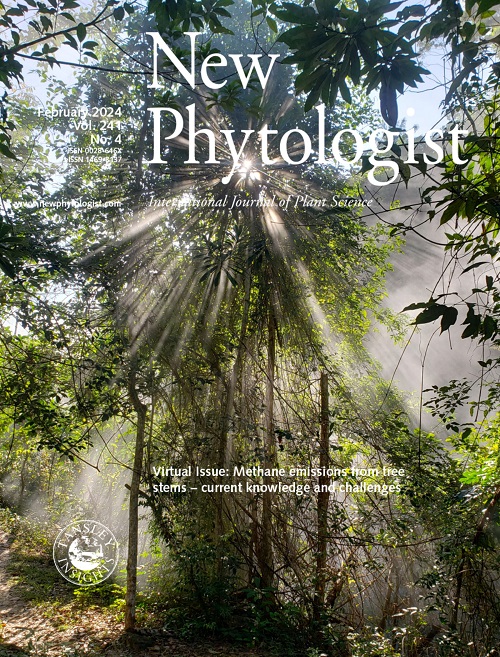The CAP superfamily protein PsCAP1 secreted by Phytophthora triggers immune responses in Nicotiana benthamiana through a leucine-rich repeat receptor-like protein
IF 8.1
1区 生物学
Q1 Agricultural and Biological Sciences
引用次数: 0
Abstract
- The role of cysteine-rich secretory proteins, antigen 5, and pathogenesis-related 1 (CAP) superfamily proteins in the innate immune responses of mammals is well characterized. However, the biological function of CAP superfamily proteins in plant–microbe interactions is poorly understood.
- We used proteomics and transcriptome analyses to dissect the apoplastic effectors secreted by the oomycete Phytophthora sojae during early infection of soybean leaves. By transiently expressing these effectors in Nicotiana benthamiana, we identified PsCAP1, a novel type of secreted CAP protein that triggers immune responses in multiple solanaceous plants including N. benthamiana. This secreted CAP protein is conserved among oomycetes, and multiple PsCAP1 homologs can be recognized by N. benthamiana.
- PsCAP1-triggered immune responses depend on the N-terminal immunogenic fragment (aa 27–151). Pretreatment of N. benthamiana with PsCAP1 or the immunogenic fragment increases plant resistance against Phytophthora. The recognition of PsCAP1 and different homologs requires the leucine-rich repeat receptor-like protein RCAP1, which associates with two central receptor-like kinases BRI1-associated receptor kinase 1 (BAK1) and suppressor of BIR1-1 (SOBIR1) in planta.
- These findings suggest that the CAP-type apoplastic effectors act as an important player in plant–microbe interactions that can be perceived by plant membrane-localized receptor to activate plant resistance.
疫霉分泌的CAP超家族蛋白PsCAP1通过富含亮氨酸的重复受体样蛋白触发本氏烟草的免疫反应
富含半胱氨酸的分泌蛋白、抗原5和发病机制相关1(CAP)超家族蛋白在哺乳动物先天免疫反应中的作用已得到充分表征。然而,CAP超家族蛋白在植物-微生物相互作用中的生物学功能尚不清楚。我们使用蛋白质组学和转录组分析来剖析大豆叶片早期感染过程中大豆疫霉菌分泌的质外体效应子。通过在本氏烟草中瞬时表达这些效应子,我们鉴定了PsCAP1,这是一种新型分泌的CAP蛋白,在包括本氏烟草在内的多种茄科植物中触发免疫反应。这种分泌的CAP蛋白在卵菌中是保守的,本氏N.benthamiana可以识别多种PsCAP1同源物。PsCAP1触发的免疫反应依赖于N-末端免疫原性片段(aa 27-151)。用PsCAP1或免疫原性片段预处理本氏N.benthamiana提高了植物对疫霉菌的抗性。PsCAP1和不同同源物的识别需要富含亮氨酸的重复序列受体样蛋白RCAP1,该蛋白与植物中的两种中心受体样激酶BRI1相关受体激酶1(BAK1)和BIR1-1抑制剂(SOBIR1)结合。这些发现表明,CAP型质外体效应子在植物-微生物相互作用中发挥着重要作用,植物膜定位受体可以感知到这种作用,从而激活植物抗性。
本文章由计算机程序翻译,如有差异,请以英文原文为准。
求助全文
约1分钟内获得全文
求助全文
来源期刊

New Phytologist
PLANT SCIENCES-
CiteScore
17.60
自引率
5.30%
发文量
728
审稿时长
1 months
期刊介绍:
New Phytologist is a leading publication that showcases exceptional and groundbreaking research in plant science and its practical applications. With a focus on five distinct sections - Physiology & Development, Environment, Interaction, Evolution, and Transformative Plant Biotechnology - the journal covers a wide array of topics ranging from cellular processes to the impact of global environmental changes. We encourage the use of interdisciplinary approaches, and our content is structured to reflect this. Our journal acknowledges the diverse techniques employed in plant science, including molecular and cell biology, functional genomics, modeling, and system-based approaches, across various subfields.
 求助内容:
求助内容: 应助结果提醒方式:
应助结果提醒方式:


